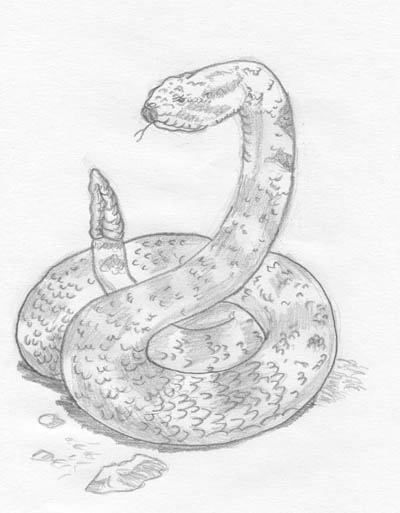Don't come any closer.....
Don't come any closer.....
Don't come any closer..... by C1umzieOn3

Description
Description
This is like, the best reptile I've ever done.<br />
<br />
• Rattlesnakes are also called pit vipers because they have a heat-sensitive organ known as a "pit" on each side of the head that helps them locate and aim at prey. A rattlesnake can detect prey that are as little as 1/10 of a degree warmer than their background!<br />
• Young rattlers leave their mothers at just a few weeks old, but when it’s time to hibernate in the winter, they follow their mother’s scent trail and use the same den. Future generations will also use the same den—some have been used for over 100 years!<br />
• The Santa Catalina Island rattlesnake Crotalus catalinensis has no rattle! It’s found only on Santa Catalina Island, off the coast of southern Baja California, Mexico. This snake climbs trees and sneaks up on its bird prey, which is easier without a noisy rattle.<br />
• Who would guess that rattlesnakes are good swimmers? They’ve been found several miles out at sea!
<br />
• Rattlesnakes are also called pit vipers because they have a heat-sensitive organ known as a "pit" on each side of the head that helps them locate and aim at prey. A rattlesnake can detect prey that are as little as 1/10 of a degree warmer than their background!<br />
• Young rattlers leave their mothers at just a few weeks old, but when it’s time to hibernate in the winter, they follow their mother’s scent trail and use the same den. Future generations will also use the same den—some have been used for over 100 years!<br />
• The Santa Catalina Island rattlesnake Crotalus catalinensis has no rattle! It’s found only on Santa Catalina Island, off the coast of southern Baja California, Mexico. This snake climbs trees and sneaks up on its bird prey, which is easier without a noisy rattle.<br />
• Who would guess that rattlesnakes are good swimmers? They’ve been found several miles out at sea!
General Info
General Info
Ratings
Category Furry » Animal art (Non-anthro) » Reptiles / Lizards
Date Submitted
Views 1124
Favorites... 0
Vote Score 0
Category Furry » Animal art (Non-anthro) » Reptiles / Lizards
Date Submitted
Views 1124
Favorites... 0
Vote Score 0
Comments
1
Media Unspecified
Time Taken
Reference
Media Unspecified
Time Taken
Reference
Comments
You are not authorized to comment here. Your must be registered and logged in to comment
Kouga_Wolfe on January 6, 2006, 4:13:57 PM
Kouga_Wolfe on
